Pricing & availability
Prices: The US4 is selling for 3,998.00 EUR and the + version goes for 4,998.00 EUR. NON EU audiophiles pay no VAT making it: 4200€ for the US4+ and 3360€ for the US4. This (EU) price is mostly because of the development, (EU) production costs and the components used. We know this is a lot of money and some are going crazy over the Niimbus pricing, but if this isn’t in your budget and you’re not prepared to pay €4-€5K for a high-end amp, then just don’t buy it and look elsewhere. Look at it like you look at a racecar: Is a Ferrari expensive? For me yes, for others it isn’t. Is the money worth it? To the owners who can afford it, it certainly is. So who would I be to say it’s too expensive for what you get. To each his own.
The Niimbus US4+ can be ordered here:
https://www.cma.audio/en/categories/headphones/headphone-amps/niimbus-us4
And here : http://violectric-usa.com/us-4_plus
Features
All the features can be found in the manual here. (download will start)
- Two unsym. Stereo inputs (RCA)
- stereo input (3-pin XLR)fcook
- Stereo output (RCA)
- stereo output (3-pin XLR)
- Two unsym. headphone outputs (6.3 mm jack)
- headphone output (4-pin XLR)
- Balance regulator
- Volume control via relay (256 levels)
- Remote Control
- Digitally controlled analogue signal path
- Input selection at the front
- Output selection at the front
- Delayed activation with power-on
- Immediate separation during power-off
- DC protection
- Overload protection
- Over temperature protection
- Ultimate circuit design
- Channel-separated construction
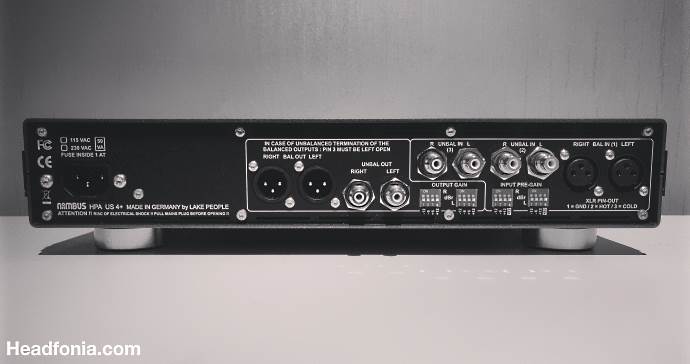
Tech Specs
| Color: | black |
| Headhone Out: | 1 (bal., XLR 4-pole), 2 |
| Chassis: | Desktop |
| output impedance: | < 15 Ohm |
| Amplifier Channels: | 2 |
| Signal to Noise Ratio (SNR): | > 129 dB (A-gew.) |
| Additional Features: | verschiedene Schutzfunktionen |
| frequency range: | 0 – 200 kHz |
| Inputs / Outputs: | 2 / 2 (bal. XLR) |
| max. output level: | 32,4 (600 Ohm) | 30,4 dBu (100 Ohm) | 27,7 dBu (50 Ohm) | 24,8 dBu (32 Ohm) | 19,4 dBu (16 Ohm) | 13,3 dBu (32 Ohm) | 7,3 dBu (16 Ohm) |
| Crosstalk: | -106 dB (1 kHz) | -105 dB (15 kHz) |
| total-harmonic-distortion (THD): | 0,00063 % (@ 10V/100 Ohm, 1W) | 0,00071 % (@ 4V/32 Ohm, 0,5W) |
| Weight: | 7,50 kg |
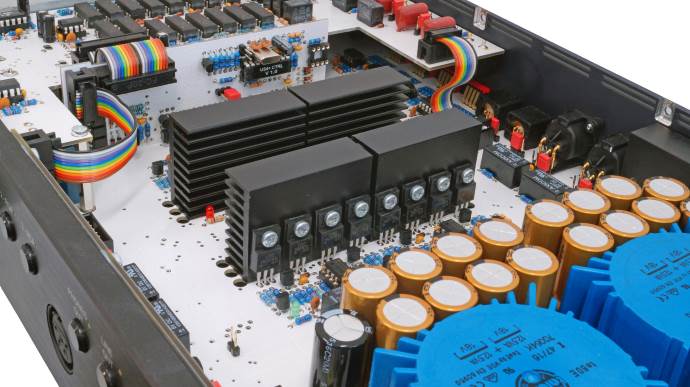
Design & Build Quality
The Violectric gear and certainly the Lake People gear’s build quality is excellent. Great cases, top quality front plate, sturdy feet. Buttons and switches are from quality brands, as well as the internals. We never ever complained about the Vio and LP gear ever and we’ve always found it to be robust and well finished.
The Niimbus gear still is robust but it also is more refined looking than the Violectric gear. The unit is more expensive but that’s also exactly how it looks, higher end. The casing is great, the buttons as good as it gets and all the connectors on the front and back are clean, sturdy and precisely integrated in the casing. The build quality of 7.5kg amp is as good as it gets really.
Design wise Mr. Reim this time decided to go for width compared to the V281 which was much taller. The design is nice and I really like the positioning of the connectors and switches on the front panel. Yes the front plate is busy but at the same time it’s not too flashy. It’s pretty and it’s “handy”, a win-win for me. The back panel is very busy with all the connectors and gain settings but it’s all on the back so it doesn’t really bother me.
Something that some Violectric clients didn’t like about he V281 was the fact that it used different color LEDs and that it at night was a bit like a disco. It never bothered me actually but I do see what they mean. Niimbus listened and now you can actually dim the lights on the front via the unit’s menu. Again, I don’t think it bothered many, but now it won’t bother anyone. The LEDs now are white and red but even at their full “strength” they now are more discreet and classy. The biggest LED is on the volume control, but it’s nice and elegant.
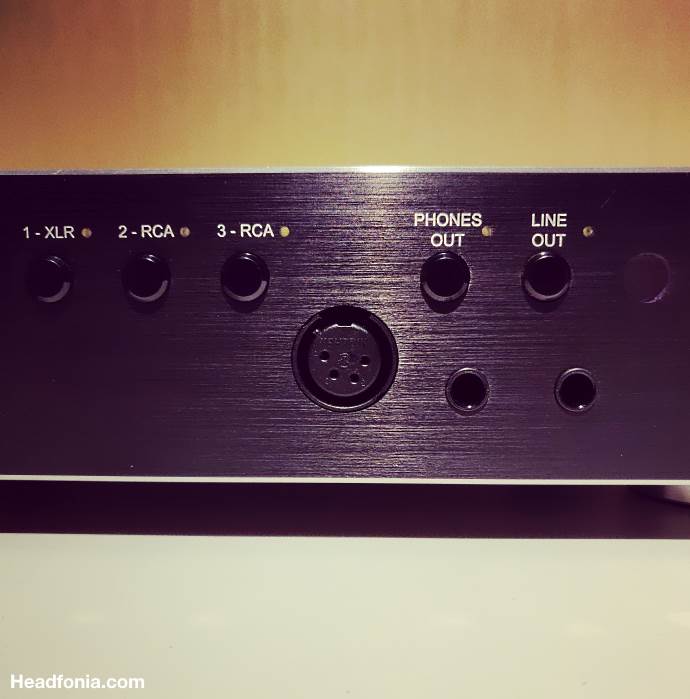
Lay-Out
Let’s start with the front panel from left to right.
- Volume dial
- Balance control
- XLR input selector
- RCA 1 input selector
- RCA 2 input selector
- Balanced headphone output
- Headphone output selector
- Single ended 6.3mm headphone output
- Line Out selector
- Single ended 6.3mm headphone output
- Status & power lights
- Main power button
The back panel is just as busy. From left to right:
- Power connector
- Balanced double XLR output
- Single Ended RCA outputs
- Top – RCA input 1
- Top – RCA input 2
- Bottom – Output gain
- Bottom – Input gain
- XLR Balanced inputs
The part on Sound starts on the next page, after the JUMP






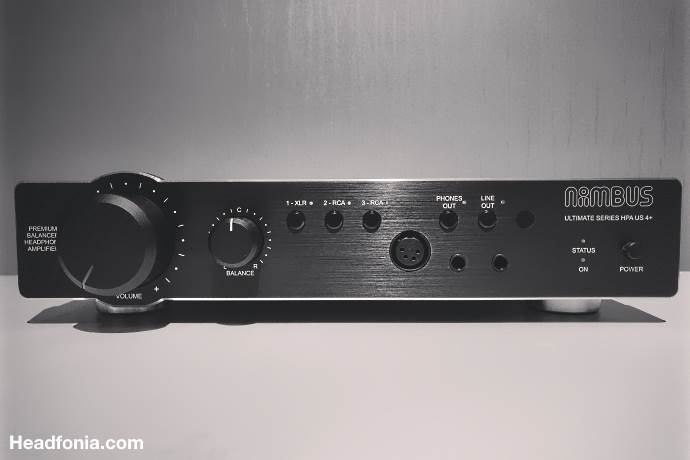

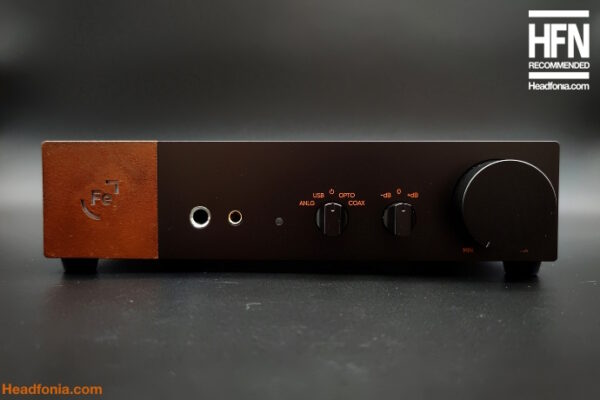
Arnie
i dont think v850 would make jusctice for amp like this. This dac i below average. We get it youre fanboy of violectric but atleast try other dacs maybe? im sure Chord qutest would do much better let alone costlier dacs. Good read though
MhtLion
v850 is not a bad DAC. It does about everything right except the detail retrieval compared to others in the price range. For a detail freak like myself, it’s not an ideal DAC. But, it can be a great DAC for music lovers who focus more on the timbre, naturalness, etc. But I do agree Chord qutest is better, and I suppose that’s about the minium DAC people, who spend 5k on a headphone amp, will use together.
Offramp
Read the owners manual, thank you L.
It is so Fried, LoL.
I’ve never read manuals the way they do them. Not only do you
understand how to operate it, you learn why it operates the
way it does.
It was just what I needed.
Always in the background
Always reading around
Lieven
Thanks for commenting 🙂
Greg
“In single ended mode the Utopia sounds lighter and more linear with less bass impact and overall better linearity and balance. The sound signature again is more neutral in single ended mode and the impact and body are more civilized. For some the balanced signature/synergy might be a bit much body wise, and those listeners for sure will prefer the single ended mode. I can appreciate both the balanced as well as the single ended output, and the Utopia does sound better in SE mode than the HE-1000SE does.”
You nailed this. Absolutely nailed this. I purchased the Niimbus 5 Pro to pair with the Utopia and the body was overwhelming (compared to my Taurus MKII). I like bass but it was just too much. I was very disappointed then found your review and switched from my XLR Gravedigger cable to a SE Gravedigger Cable. So much better. You clearly take the time to listen and try different uses and to do that with multiple headphones – impressive!
Lieven
Thank you Greg for the nice words. I have sold my Utopia in the meantime though 🙂